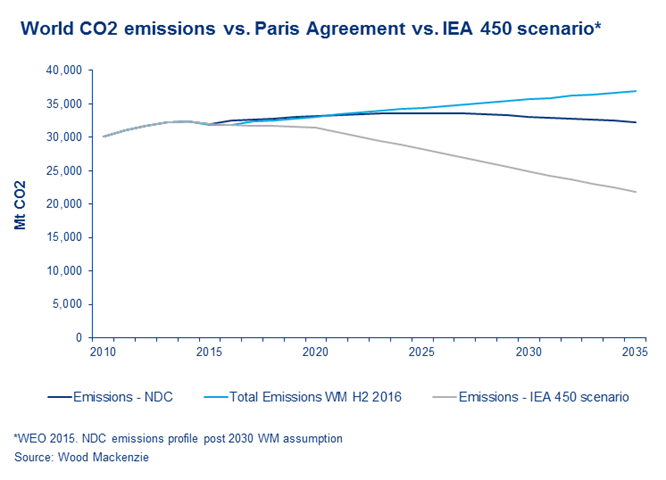Discuss your challenges with our solutions experts
The Paris Agreement has been ratified by 87 countries including China, India and the United States. To limit greenhouse gas emissions, many countries have already increased focus on energy efficiency, renewable energy and switching away from coal. But will it be enough?
Up to 50% of Majors’ production could be hit with carbon costs over the next decade. Our recent study investigates how the major oil companies are responding to growing pressure to move to a low carbon-energy environment.
Emission omission: What does the Paris Agreement promise?
The Paris Agreement aims to prevent the global average temperature from rising more than 2°C and will pursue efforts to limit the temperature increase to 1.5°C. Of the 197 countries who signed the agreement, 87 have ratified the deal. But developing countries are likely to achieve emission-limiting targets more easily than developed countries.
Paris Agreement implications
Paul McConnell, Research Director for Global Trends, sheds some light on the study and our recent analysis.
Developing vs developed markets
The countries represented in the agreement fall into two groups. Emerging markets like China and India have adopted targets that should be easy to meet. China has promised to cut the CO2 intensity of its economy by 60% to 65% by 2030 whilst India's target is a 33-35% intensity cut over the same timeframe.
We believe China will beat their target by a significant margin and deliver a 70% cut in terms of the CO2 intensity by 2030.
Developed markets will find targets more challenging. In Europe, emerging technologies in renewables, decarbonisation policies and increased efficiency have already prompted a move away from the most polluting fossil fuels. To meet targets in the developed worlds, we expect continued pressure on emissions.
Which countries do you expect to meet Paris Agreement targets?
We asked Paul McConnell to share his thoughts on the agreement's goals.
Judging the pace of transition from old to new is among the big difficulties facing companies as they survey this emerging energy landscape. Companies will need to change, beginning with understanding their own carbon footprint, then developing strategies to adapt.
What happens next?
Our analysis shows that a formalised global policy framework favouring low-carbon energy challenges the traditional business models in oil and gas production, coal extraction and power utilities in the longer run. We expect much more pressure to be applied to participants of the Paris Agreement from now until 2020 and beyond. Countries will be bound by open-ended constraints on carbon dioxide and other GHG emissions, many for the first time in history.
